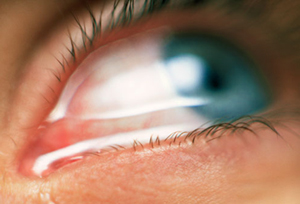Introduction
If you could be a fly on the exam room wall of your local ophthalmologist, you would hear patient after patient report symptoms of dry eye disease.
Some patients come in already knowing they have dry eyes. However, the variability of symptoms that can occur from dry eye disease is so wide many patients don’t even use the word “dry.” We will cover some of these symptoms in this article.

Underlying Factors
Dry eye disease has many underlying factors including an inadequate production of tears, rapid evaporation of tears, poor eyelid function and an imbalance in the tear composition of water, oil, and mucus. Dry eye disease can be associated with systemic conditions such as Sjogrens disease, Sarcoid disease and sleep apnea among many others. It is more common in females especially after hormonal changes such as menopause.
Exacerbating Influences
Many medications can exacerbate dry eye disease. Over the counter antihistamines are one example.
Environmental factors may also worsen dry eye symptoms. These include dry climates, windy weather conditions, smoky environments and the dry air found in airplanes.
Modern life includes hours and hours of focusing our eyes on everything from cell phones to computer screens to television. Prolonged focusing reduces the blink rate resulting in more tear evaporation and worsening of dry eye symptoms. Increased evaporation can also occur with exposure to heating, air conditioning, fans and rolling down the car windows while driving.
Symptoms Fluctuate
It is very common for dry eye symptoms (especially blurred vision) to wax and wane throughout the day. Symptoms can even change from blink-to-blink. Dry eye disease which is predominately due to insufficient tears tends to worsen throughout the day with symptoms worse at night. Dry eye disease that is more associated with blepharitis can be worse in the morning. Blepharitis is associated with burning and itching of the eyes.
Visual Symptoms
The front surface of the eye is the most powerful focusing surface of the eye. Thus, a dry ocular surface will produce visual symptoms. These symptoms can include:
Blurred vision: A decrease or fluctuation in visual acuity. This is manifested in the inability to see fine detail. Objects at both near and far may appear out of focus.
Sensitivity to light: Sensitivity to light is termed photophobia. It occurs because a dry ocular surface has more irregularities than a health surface. These irregularities scatter light entering the eye. This scattered light can cause significant discomfort. The inability to tolerate light may lead to squinting and headaches.
Difficulty with nighttime driving: During low light conditions, such as at night, the pupil enlarges and allows more light into the eye. When the ocular surface is dry, the incoming light becomes unfocused and scattered. Many of these abnormalities are filtered out by the small size of the pupil during the day. However, at night, the larger pupil size allows more light abnormalities to pass through to the retina. This results in nighttime glare and halos. Glare is a decreased tolerance of bright lights. Halos present as circles or auras around a bright source of light. Glare and halos from the headlights of oncoming traffic are especially troublesome.
Physical Symptoms
The front surface of the eye is richly supplied with nerve endings. As such, a dry ocular surface can result in significant symptoms of discomfort. In addition to feeling dry, these symptoms include:
Foreign body sensation: Patients may feel as if there is something present in the eye.
Redness of the eye: Enlarged blood vessels on the ocular surface cause the eye to look red.
Ocular and periocular pain: Pain from dry eye can be mild or severe. Pain from dry eye can be felt on the ocular surface. Pain can also be felt in structures around the eye such as the eyelids or scalp.
Periocular irritation: Stinging, burning, or itching sensations of the ocular surface and eyelids.

Watery eyes: Patients typically raise an eyebrow or two when I explain how the tearing they are experiencing is from dryness. “How can my eyes be dry if they are watering all of the time?” Although this may seem counter-intuitive, when the ocular surface is very dry it will overproduce the watery component of the tears as a protective mechanism.
Eye fatigue: A tired sensation of the eyes and heaviness of the eyelids.
Decreased tolerance of sustained visual focusing: As noted earlier, any activity that requires prolonged visual attention will decrease the blink rate and increase tear evaporation.
Discomfort while wearing contact lenses: Individuals may experience pain and irritation in the eyes while inserting or wearing contact lenses.
Inability to cry: Tears associated with emotional discomfort or watching a sad movie may be decreased in some types of dry eye disease.
Stringy discharge from the eye: A dry ocular surface can result in the overproduction of a sticky, mucus discharge.
Conclusion
There are many symptoms of dry eye disease. Some symptoms affect vision and others affect ocular comfort. If symptoms persist, an evaluation by your eye care provider can help clarify the cause and offer information on treatment options.
It is important to remember the symptoms of dry eye disease can overlap with the symptoms of other ocular conditions. One example is cataracts which, like dry eye disease, can also cause blurred vision and nighttime glare. The next post in this series will review how dry eye disease (and its sub-types) are diagnosed.
As a final note, while the name “dry eye disease” may sound innocuous, the symptoms of dry eye disease can be very severe in many patients. If you suffer from dry eye disease, you are not alone. Today there are many treatment options which can be very helpful. Significant research is underway to continue improving our ability to treat dry eye disease.
 Matthew Wade, MD
Matthew Wade, MD
Assistant Professor of Ophthalmology
Gavin Herbert Eye Institute
Minal Reddy was also a contributor to the is article.

